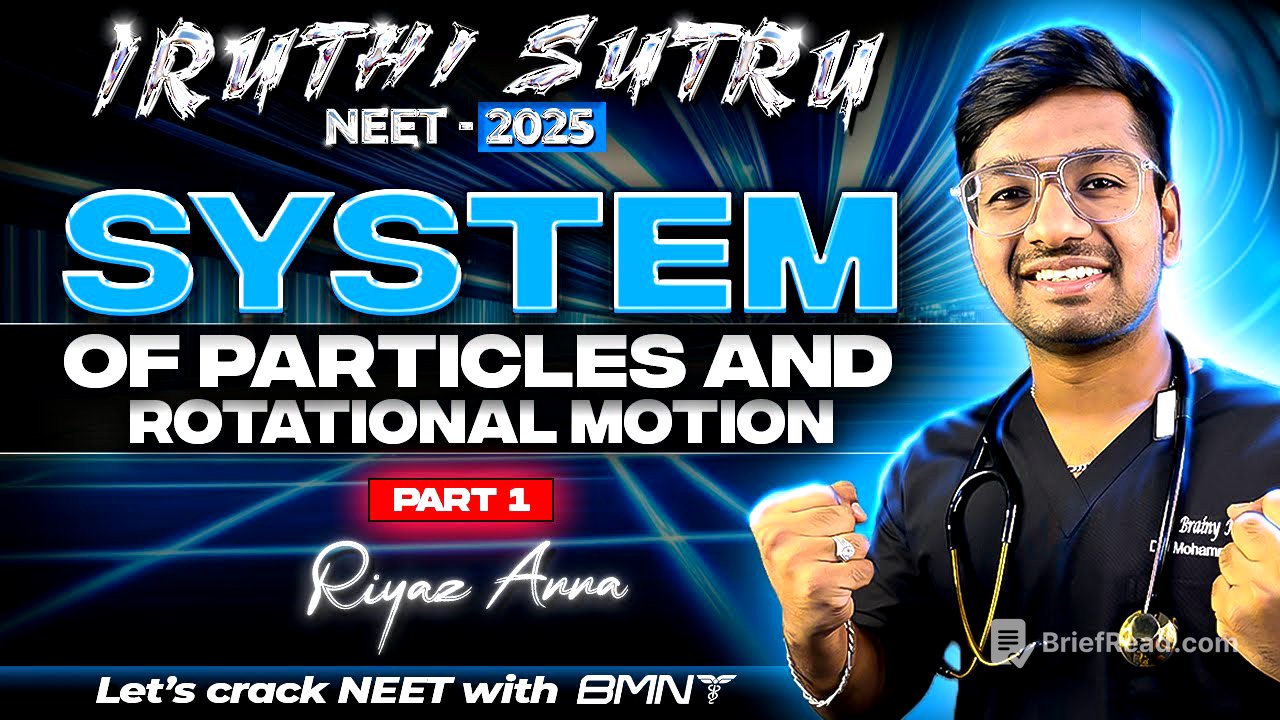TLDR;
This YouTube video by Brainymedic NEET [தமிழ்] covers the concepts of collisions, including head-on and oblique collisions, elastic and inelastic collisions, and perfectly inelastic collisions. It also discusses the center of mass and related formulas, providing examples and problem-solving. The video emphasizes understanding the concepts rather than memorizing formulas and includes practice problems for viewers to solve.
- Types of Collisions
- Elastic and Inelastic Collisions
- Center of Mass
Introduction [0:54]
The session begins with greetings and a request to share the session. The instructor expresses hope that the video and audio are clear and indicates that the session will be long and intensive.
Collision Definition and Types [6:51]
A collision is defined as a brief interaction between two bodies involving the exchange of linear momentum and kinetic energy, with or without physical contact. The instructor mentions that mechanical energy may or may not be conserved during a collision. There are two major types of collisions: head-on collisions and oblique collisions.
Head-on Collisions [15:06]
In a head-on collision, two masses move along the same line of motion. The velocity of the first mass (u1) is greater than the velocity of the second mass (u2). After the collision, there may be heat loss.
Oblique Collisions [20:16]
In oblique collisions, the masses do not move along the same line of motion. The line of impact is the direction of the force exerted during the collision.
Elastic Collisions [27:41]
Elastic collisions are those in which objects return to their original shape after impact. During an elastic collision, there may be a small deformation, but the elastic potential energy is completely restored to the system. Kinetic energy is conserved.
Inelastic Collisions [42:21]
In inelastic collisions, some kinetic energy is lost, often converted into heat or other forms of energy.
Perfectly Inelastic Collisions [42:46]
In perfectly inelastic collisions, the objects stick together after the collision. Kinetic energy is not conserved throughout the collision, but linear momentum is conserved.
Conservation of Linear Momentum [52:53]
During any kind of collision, linear momentum is conserved. The instructor emphasizes understanding the concept rather than memorizing formulas. The relative velocity of approach before the collision and the relative velocity of separation after the collision are key concepts.
Coefficient of Restitution [1:03:17]
The coefficient of restitution (e) is the ratio of the relative velocity of separation to the relative velocity of approach. For perfectly elastic collisions, e = 1; for perfectly inelastic collisions, e = 0; and for other collisions, e is between 0 and 1.
Practice Problem: Perfectly Inelastic Collision [1:20:53]
Two particles of mass 1 kg and 2 kg are moving with speeds of 2 m/s and 5 m/s, respectively. They combine perfectly inelastically. The task is to find the final velocity and the loss in kinetic energy.
Practice Problem: Collision with Direction [1:25:18]
Two particles of mass 1 kg each are moving. One is moving in a positive direction, and another 2 kg particle arrives and collides with a speed of 5 m/s. The task is to find the common velocity and kinetic energy loss.
Practice Problem: Elastic Collision in Opposite Directions [1:35:12]
Two particles of equal mass are moving with speeds u1 and u2 in opposite directions. After colliding elastically, their velocities are exchanged.
Maximum Potential Energy Storage [1:56:35]
The instructor discusses the concept of maximum potential energy storage and asks viewers to comment with the answer.
Finding Velocity After Collision [1:57:53]
The task is to find the velocity of mass after the collision. The instructor uses conservation of linear momentum and the coefficient of restitution to solve the problem.
Bullet and Wood Block Problem [2:02:04]
A bullet hits a wood block. The instructor provides formulas to calculate the common velocity and the height the block reaches.
Center of Mass Definition [2:08:09]
The center of mass is the point where the entire mass of an object is concentrated. The instructor uses examples to illustrate the concept.
Center of Mass Formula [2:14:50]
The formula for the center of mass is given as R = (m1r1 + m2r2 + m3r3 + ... + mnrn) / (m1 + m2 + m3 + ... + mn). The instructor also discusses how to write rough work in the exam paper.
Center of Mass Calculation [2:21:33]
The instructor explains how to calculate the center of mass in one dimension (x-coordinate) and two dimensions (x and y coordinates).
Center of Mass Practice Problems [2:31:27]
The instructor presents several practice problems to calculate the center of mass for different mass configurations.
Center of Mass of a Semicircular Ring [2:54:38]
The center of mass of a semicircular ring is discussed, with the x-coordinate being 0 and the y-coordinate being 2r/π.
Moment of Inertia [2:55:19]
The instructor mentions that the next topic will be the moment of inertia and related concepts, including conservation of angular momentum.









